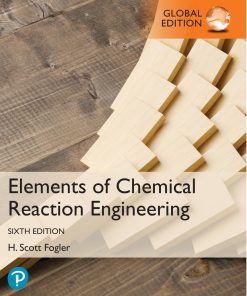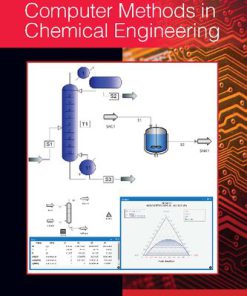Chemical Reaction Engineering A Computer Aided Approach 2nd Edition by Tapio Salmi, Johan Warna, Jose Rafael Hernandez Carucci, Cesar De Araujo Filho 3110797976 9783110797978
$50.00 Original price was: $50.00.$25.00Current price is: $25.00.
Chemical Reaction Engineering A Computer Aided Approach 2nd Edition by Tapio Salmi, Johan Warna, Jose Rafael Hernandez Carucci, Cesar De Araujo Filho – Ebook PDF Instant Download/Delivery: 3110797976, 9783110797978
Full download Chemical Reaction Engineering A Computer Aided Approach 2nd Edition after payment

Product details:
ISBN 10: 3110797976
ISBN 13: 9783110797978
Author: Tapio Salmi; Johan Wärnå; José Rafael Hernández Carucci; César A. de Araújo Filho
Follow step-by-step explanations to understand mathematical models – algebraic and differential equations – of chemical reactors and how numerical models workin computer implementation. Learn the basics behind current user-friendly tools in numerical simulation and optimization of reactor systems (Python, Matlab, Julia and gPROMS). Discover how to select the right algorithm for specific reactor models from homogenous to multiphase systems and structured reactors in detailed discussions at the end of each chapter. In this second edition, 20 solved example simulations performed in MATLAB and Python are included for demonstration purposes. Download solutions to exercises in the book: http://web.abo.fi/fak/tkf/tek/cre/. .
Chemical Reaction Engineering A Computer Aided Approach 2nd Table of contents:
1 Introduction
2 Kinetics in reaction engineering
2.1 Stoichiometry of multiple reactions
2.2 Reaction kinetics in chemical reaction engineering
2.2.1 General concepts
2.2.2 Examples of rate equations
3 Modelling of homogeneous systems
3.1 Mass balances for completely backmixed tank reactors: batch, semi-batch and continuous operation
3.2 Mass balances for tubular reactors
3.3 Energy balances of homogeneous systems
3.3.1 Tank reactor
3.3.2 Tubular plug flow reactor
3.3.3 Batch reactor
3.3.4 Semi-batch reactors
3.4 Physical properties and correlations of homogeneous systems
3.4.1 Heat capacity and reaction enthalpy
3.4.2 Pressure drop in tubular reactors
3.4.3 Dispersion coefficient
3.5 Numerical solution of homogeneous reactor models
3.5.1 Model structures and algorithms
3.5.2 Software build-up
4 Modelling of fixed beds and fluidized beds
4.1 Simultaneous reaction and diffusion in fluid films and porous media
4.2 Catalytic fixed bed reactors
4.2.1 Models for fixed beds
4.2.2 Pseudo-homogeneous models for fixed beds
4.2.3 Heterogeneous model for fixed beds
4.2.4 Model equations for the bulk phase
4.2.5 Pressure drop in fixed beds
4.3 Numerical solution of fixed bed models
4.3.1 Solution of pseudo-homogeneous models
4.3.2 Solution strategy of heterogeneous models
4.4 Catalytic fluidized beds
4.4.1 Modelling approaches to fluidized beds
4.4.2 Kunii-Levenspiel model of fluidized beds
4.5 Numerical solution of fluidized bed models
4.6 Physical properties and correlations for catalytic two-phase systems
4.6.1 Effective diffusion coefficients in a gas phase
4.6.2 Mass and heat transfer coefficients around solid particles
4.6.3 Mass transfer coefficients for fluidized beds
5 Modelling of three-phase systems
5.1 Mass balances of three-phase reactors
5.1.1 Phase boundaries
5.1.2 Liquid-phase mass balances
5.1.3 Gas-phase mass balances
5.1.4 Tank reactors with complete backmixing
5.1.5 Catalyst particles in three-phase reactors
5.1.6 Slurry reactor in the absence of mass transfer resistances
5.2 Energy balances of three-phase reactors
5.3 Numerical aspects
6 Modelling of gas-liquid systems
6.1 Gas-liquid contact
6.2 Gas and liquid films
6.2.1 Mass balances for films
6.2.2 Energy balances for liquid films
6.3 Gas-liquid tank reactors
6.4 Gas-liquid column reactors
Boundary conditions for balance equations
6.5 Energy balances for gas-liquid reactors
6.6 Physical properties of gas-liquid systems
6.6.1 Diffusion coefficients in gas and liquid
6.6.2 Gas-liquid equilibrium
6.7 Numerical strategies for gas-liquid reactor models
7 Structured reactors
7.1 Modelling principles and model equations
7.2 Case study: oxidation of alcohols in microreactor
8 Modelling of unsteady-state reactor systems
8.1 Kinetics and transport phenomena under transient conditions
8.2 Reactor modelling in case of transient kinetics
8.2.1 Gas- and liquid-phase mass balances
8.2.2 Adsorbed surface species
8.2.3 Model summary
8.3 Case study: enantioselective hydrogenation of an organic compound
9 Equipment and models for laboratory experiments
9.1 Homogeneous batch reactor
9.2 Homogeneous stirred tank reactor (CSTR)
9.3 Catalytic fixed bed in integral mode
9.4 Catalytic differential reactor
9.5 Catalytic gradientless reactor
9.6 Catalytic slurry reactor
9.7 Classification of laboratory reactor models
9.7.1 Algebraic and differential models
9.7.2 Linearity and nonlinearity of the model
10 Parameter estimation in reaction engineering
10.1 Principles of nonlinear regression analysis
10.2 Statistical and sensitivity analysis of parameters
10.3 Suppression of correlation between parameters
10.3.1 Correlation in rate expressions
10.3.2 Correlation in temperature dependencies
10.4 Systematic deviations and normalization of experimental data
10.5 Direct integral method
10.6 Parameter estimation from non-isothermal data
10.7 Estimation of parameters from semibatch experiments
10.7.1 Composite reactions in the presence of a heterogeneous catalyst
10.7.2 Composite reactions in the presence of a homogeneous catalyst
References
Exercises
I Gas-phase tube reactor
II Synthesis of maleic acid monoester in a semi-batch reactor
III Exothermic reaction in a continuous stirred tank reactor
IV Production of phtalic anhydride in a fixed bed reactor
V Water-gas shift in a fixed bed reactor: diffusional limitations
VI Steady-state CSTR’s in series: oxidation of Iron(II) to Iron(III)
VII A fluidized bed reactor
VIII Three-phase slurry reactor: hydrogenation of aromatics
IX Chlorination of p-cresol in a continuous stirred tank reactor
X Reaction between methanol and triphenyl methyl chloride
XI Use of millireactor for the kinetic study of very fast reaction: dehydrochlorination of 1,3-dichloro-2-propanol
XII Multiple liquid-phase reaction system
XIII Gas-liquid reactions in a semi-batch reactor
XIV Gas-phase reaction in a differential reactor
XV Three-phase reactions in a semi-batch reactor
XVI Non-isothermal liquid phase reaction in a CSTR
XVII Oxidation of sulphur dioxide in an optimal multi-bed reactor system
XVIII Modelling of a monolith channel
XIX Heterogeneous two-dimensional model for a catalytic fixed-bed reactor
XX Dissolution of a solid particle in a batch reactor
People also search for Chemical Reaction Engineering A Computer Aided Approach 2nd:
8 chemical reactions
5 chemical reactions
v chemical
chem e car reactions
Tags:
Tapio Salmi,Johan Warna,Jose Rafael Hernandez Carucci,Chemical,Computer
You may also like…
Uncategorized
Chemistry - Technical & Industrial Chemistry
Elements of Chemical Reaction Engineering, Global Edition, 6th Edition H. Fogler
Engineering - Chemical Engineering
Uncategorized
Solutions Manual for Essentials of Chemical Reaction Engineering Second Edition H. Scott Fogler
Uncategorized











